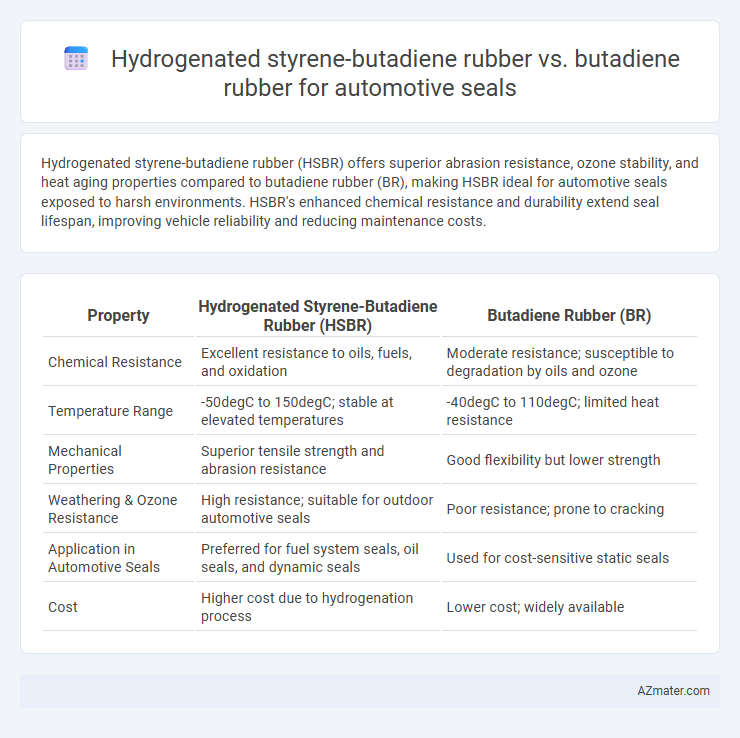Hydrogenated styrene-butadiene rubber (HSBR) offers superior abrasion resistance, ozone stability, and heat aging properties compared to butadiene rubber (BR), making HSBR ideal for automotive seals exposed to harsh environments. HSBR's enhanced chemical resistance and durability extend seal lifespan, improving vehicle reliability and reducing maintenance costs.
Table of Comparison
| Property | Hydrogenated Styrene-Butadiene Rubber (HSBR) | Butadiene Rubber (BR) |
|---|---|---|
| Chemical Resistance | Excellent resistance to oils, fuels, and oxidation | Moderate resistance; susceptible to degradation by oils and ozone |
| Temperature Range | -50degC to 150degC; stable at elevated temperatures | -40degC to 110degC; limited heat resistance |
| Mechanical Properties | Superior tensile strength and abrasion resistance | Good flexibility but lower strength |
| Weathering & Ozone Resistance | High resistance; suitable for outdoor automotive seals | Poor resistance; prone to cracking |
| Application in Automotive Seals | Preferred for fuel system seals, oil seals, and dynamic seals | Used for cost-sensitive static seals |
| Cost | Higher cost due to hydrogenation process | Lower cost; widely available |
Introduction to Automotive Seal Materials
Hydrogenated styrene-butadiene rubber (HSBR) offers superior resistance to heat, ozone, and abrasion compared to butadiene rubber (BR), making it highly suitable for automotive seals exposed to harsh engine environments. The saturation of the polymer backbone in HSBR enhances chemical stability and longevity, crucial for maintaining seal integrity under extreme temperature fluctuations and exposure to automotive fluids. Although butadiene rubber provides excellent flexibility and low-temperature performance, HSBR's improved durability and aging resistance make it the preferred choice for high-performance automotive sealing applications.
Overview of Hydrogenated Styrene-Butadiene Rubber (HSBR)
Hydrogenated Styrene-Butadiene Rubber (HSBR) is a specialized synthetic elastomer renowned for its enhanced resistance to heat, ozone, and chemical degradation, making it ideal for automotive seals exposed to harsh engine environments. Compared to standard Butadiene Rubber (BR), HSBR offers superior durability and mechanical stability, extending seal life and performance in high-temperature applications. Its hydrogenation process reduces unsaturation in the polymer chain, significantly improving oxidative stability critical for maintaining seal integrity in automotive systems.
Properties of Butadiene Rubber (BR)
Butadiene Rubber (BR) offers superior abrasion resistance and low-temperature flexibility, making it highly suitable for automotive seals exposed to varying thermal conditions. Its high resilience and tensile strength provide excellent durability against mechanical stress and dynamic movements in vehicle environments. BR also demonstrates good aging resistance and oil resistance, enhancing the longevity and performance of automotive seals compared to hydrogenated styrene-butadiene rubber.
Performance Requirements for Automotive Seals
Hydrogenated styrene-butadiene rubber (HSBR) offers superior heat resistance, ozone resistance, and mechanical strength compared to butadiene rubber (BR), making it ideal for high-temperature automotive seal applications. HSBR's enhanced aging stability and low compression set ensure long-lasting sealing performance under harsh engine conditions. In contrast, BR provides good flexibility and cost-effectiveness but falls short in durability and resistance to oxidative degradation required for demanding automotive seal environments.
Durability Comparison: HSBR vs BR
Hydrogenated Styrene-Butadiene Rubber (HSBR) demonstrates superior durability compared to Butadiene Rubber (BR) in automotive seals due to its enhanced resistance to heat, ozone, and oxidative aging. HSBR's hydrogenation process significantly improves its chemical stability, resulting in prolonged service life under harsh conditions typically found in engine compartments. In contrast, BR exhibits lower resistance to thermal degradation, making HSBR the preferred choice for automotive applications requiring long-lasting, durable sealing solutions.
Chemical and Weather Resistance Differences
Hydrogenated styrene-butadiene rubber (HSBR) exhibits superior chemical resistance compared to butadiene rubber (BR) due to its saturated polymer backbone, enhancing its stability against oils, fuels, and solvents commonly encountered in automotive environments. HSBR also offers significantly better weather resistance, including improved resistance to ozone, UV radiation, and thermal degradation, which is critical for automotive seals exposed to varying climates. In contrast, butadiene rubber, with its unsaturated double bonds, is more prone to oxidative and weather-related degradation, limiting its durability and lifespan in automotive sealing applications.
Processing and Manufacturability
Hydrogenated styrene-butadiene rubber (HSBR) offers superior resistance to heat, oxidation, and ozone compared to standard butadiene rubber (BR), enhancing processing stability during automotive seal manufacturing. HSBR's enhanced chemical structure results in improved extrusion and molding capabilities, allowing for precise, consistent seal shapes with less degradation over time. In contrast, BR requires more stringent processing controls due to lower thermal stability, which can affect manufacturability and long-term seal performance in automotive applications.
Cost Considerations and Economic Impact
Hydrogenated styrene-butadiene rubber (HSBR) offers enhanced chemical resistance and durability compared to butadiene rubber (BR), but typically incurs higher production costs due to its complex hydrogenation process. The elevated expense of HSBR can impact the overall manufacturing budget of automotive seals, yet its superior lifespan and performance may reduce long-term replacement and maintenance costs. In contrast, BR provides a cost-effective initial investment with adequate performance, making it a preferred choice for budget-sensitive applications where extreme durability is less critical.
Environmental and Sustainability Aspects
Hydrogenated styrene-butadiene rubber (HSBR) offers enhanced resistance to heat, ozone, and aging compared to traditional butadiene rubber, enabling longer service life and reducing material waste in automotive seals. HSBR's improved durability supports sustainability by minimizing the frequency of seal replacements, consequently lowering the environmental footprint associated with manufacturing and disposal processes. Although butadiene rubber is less chemically modified and potentially more recyclable, HSBR's superior performance aligns better with eco-friendly automotive design goals aimed at extended product lifespan and reduced resource consumption.
Application Suitability: Choosing the Right Rubber for Automotive Seals
Hydrogenated styrene-butadiene rubber (HSBR) offers superior resistance to heat, ozone, and chemical degradation, making it highly suitable for automotive seals exposed to harsh under-the-hood conditions. Butadiene rubber (BR), while providing excellent low-temperature flexibility and abrasion resistance, typically lacks the enhanced aging and oil resistance required for long-term durability in automotive sealing applications. Selecting HSBR ensures better performance and longevity in seals subjected to extreme temperatures and exposure to automotive fluids.

Infographic: Hydrogenated styrene-butadiene rubber vs Butadiene rubber for Automotive seal
 azmater.com
azmater.com